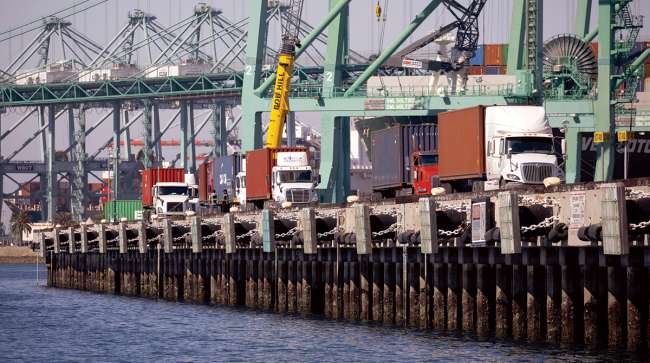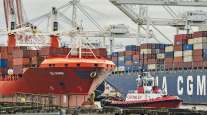Senior Reporter
Ports of L.A., Long Beach to Fine Firms Over Container Backlog

[Stay on top of transportation news: Get TTNews in your inbox.]
In an effort to clear the growing backlog of containers, the ports of Los Angeles and Long Beach are charging shippers a container storage surcharge that port officials say will increase based on the number of days a unit sits in one of the facilities.
The fees went into effect Nov. 1. The move comes as tens of thousands of containers are sitting in port yards, off-site locations and stacked on top of chassis, causing a severe chassis shortage for drayage drivers and others.
“We have a crisis in front of us, and everyone needs to be at the table,” Port of Long Beach Executive Director Mario Cordero told Transport Topics. “The carriers are doing all they can to address this issue. I think the fee, No. 1, the objective, was to make sure that we take measures to get people to move the cargo.”

Cordero
Cordero said that despite the escalating nature of the fees, he insists the two ports did not institute them as a punishment or revenue source. He does not want the fee to be used as a so-called pass-through, with the ocean carriers charging its customers further down the line.
“There is no incentive here for us to create a revenue source,” Cordero said. “But we’re in a crisis, and in a crisis, you have to take measures to try and accomplish our objectives.”
Cordero said in an ideal world, the containers would be cleared out and the yards emptied by sometime after the upcoming holidays.
“The ocean carriers are not in the business of absorbing costs; they are in the business of making money,” Harbor Trucking Association CEO Matt Schrap told TT. “The ocean carriers are charging us every day for those containers that we can’t even return into the terminals.”
Surcharge update: For containers moving by rail, ocean carriers will be charged if the container has dwelled for six days or more. https://t.co/nygXl0oCkN https://t.co/mMZAjGDPv9 — Port of Los Angeles (@PortofLA) October 27, 2021
The ports will charge ocean carriers for each container that falls into one of two categories. For containers scheduled to move by truck, ocean carriers will be charged for every container sitting nine days or more. For containers moving by rail, ocean carriers will be charged for containers dwelling for six days or more.
The ports are charging ocean carriers with cargo in those two categories $100 per container, increasing in $100 increments per container per day.
“As an incentive, putting a fee on the ocean carrier when it’s up to the cargo owner to pick up the cargo is a rather indirect mechanism, and we were a bit surprised by that,” World Shipping Council President John Butler told TT. “But everyone recognizes the need to take extraordinary action to get some of this backlog off of the terminals. But some of the members say their customers are using the terminals for storage for cargo they don’t need right now. But the trouble with that is it gums up the system for everyone.”
As recently as the week of Oct. 25, officials at both ports said more than 94,100 containers were sitting on the docks.
“It’s a container graveyard out here; we are drowning in empties,” Schlapp said. “I know of no single retailer that doesn’t want to pick their cargo up off of the dock. But the only reason they’re being prevented from picking it up is, it’s in a closed terminal, or you cannot secure an appointment to return the empty container to free up the chassis to move the import off of the dock. People have no desire to use the docks as storage.”
IHS Markit transportation economist Paul Bingham told TT one of the biggest problems the adjacent ports face is the lack of available warehouse space in Southern California. According to a report from real estate firm CBRE, a nationwide shortage of warehouse space is exacerbating the problem. Industrial warehouse space in the third quarter was the tightest in 20 years, and CBRE said demand exceeded supply by 41 million square feet. The national vacancy rate dropped to 3.6% in July, August and September, compared with 4.3% last year. Near Long Beach and Los Angeles, the vacancy rate is 1%, down from 2.3% in 2020.
He also is closely watching the new fees at the two ports to see if the charges have an immediate impact on the number of containers that are waiting to be picked up.
“We’ve just seen this fee, this emergency fee imposed by the ports with the encouragement of the federal government, and they’re using price signals to say to them, ‘Let’s use pricing and put that back into place,’ ” he said. “All of these proposals to move freight are potentially useful at the margins if you better organize some of the intermodal freight activity out of Southern California so that you can release some of the pressure, but none of it is overnight.”
Want more news? Listen to today's daily briefing below or go here for more info:




